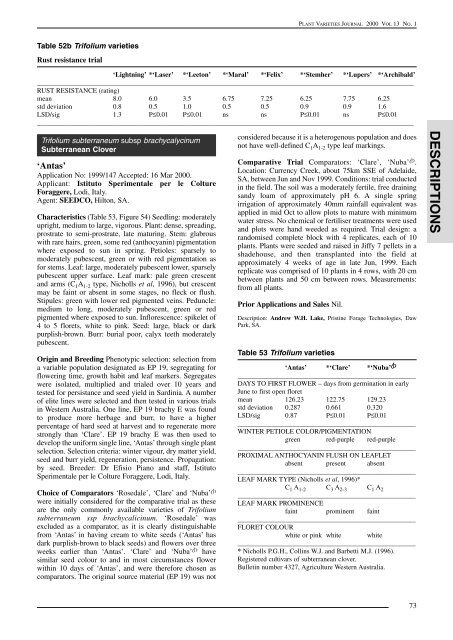53. Volume 13- Number 1 - IP Australia
53. Volume 13- Number 1 - IP Australia
53. Volume 13- Number 1 - IP Australia
Create successful ePaper yourself
Turn your PDF publications into a flip-book with our unique Google optimized e-Paper software.
DESCR<strong>IP</strong>TIONS<br />
PLANT VARIETIES JOURNAL 2000 VOL <strong>13</strong> NO. 1<br />
Table 52b Trifolium varieties<br />
Rust resistance trial<br />
‘Lightning’ *‘Laser’ *‘Leeton’ *‘Maral’ *‘Felix’ *‘Stemher’ *‘Lupers’ *‘Archibald’<br />
______________________________________________________________________________________________________________<br />
RUST RESISTANCE (rating)<br />
mean 8.0 6.0 3.5 6.75 7.25 6.25 7.75 6.25<br />
std deviation 0.8 0.5 1.0 0.5 0.5 0.9 0.9 1.6<br />
LSD/sig 1.3 P≤0.01 P≤0.01 ns ns P≤0.01 ns P≤0.01<br />
______________________________________________________________________________________________________________<br />
Trifolium subterraneum subsp brachycalycinum<br />
Subterranean Clover<br />
‘Antas’<br />
Application No: 1999/147 Accepted: 16 Mar 2000.<br />
Applicant: Istituto Sperimentale per le Colture<br />
Foraggere, Lodi, Italy.<br />
Agent: SEEDCO, Hilton, SA.<br />
Characteristics (Table 53, Figure 54) Seedling: moderately<br />
upright, medium to large, vigorous. Plant: dense, spreading,<br />
prostrate to semi-prostrate, late maturing. Stem: glabrous<br />
with rare hairs, green, some red (anthocyanin) pigmentation<br />
where exposed to sun in spring. Petioles: sparsely to<br />
moderately pubescent, green or with red pigmentation as<br />
for stems. Leaf: large, moderately pubescent lower, sparsely<br />
pubescent upper surface. Leaf mark: pale green crescent<br />
and arms (C 1 A 1-2 type, Nicholls et al, 1996), but crescent<br />
may be faint or absent in some stages, no fleck or flush.<br />
Stipules: green with lower red pigmented veins. Peduncle:<br />
medium to long, moderately pubescent, green or red<br />
pigmented where exposed to sun. Inflorescence: spikelet of<br />
4 to 5 florets, white to pink. Seed: large, black or dark<br />
purplish-brown. Burr: burial poor, calyx teeth moderately<br />
pubescent.<br />
Origin and Breeding Phenotypic selection: selection from<br />
a variable population designated as EP 19, segregating for<br />
flowering time, growth habit and leaf markers. Segregates<br />
were isolated, multiplied and trialed over 10 years and<br />
tested for persistance and seed yield in Sardinia. A number<br />
of elite lines were selected and then tested in various trials<br />
in Western <strong>Australia</strong>. One line, EP 19 brachy E was found<br />
to produce more herbage and burr, to have a higher<br />
percentage of hard seed at harvest and to regenerate more<br />
strongly than ‘Clare’. EP 19 brachy E was then used to<br />
develop the uniform single line, ‘Antas’ through single plant<br />
selection. Selection criteria: winter vigour, dry matter yield,<br />
seed and burr yield, regeneration, persistence. Propagation:<br />
by seed. Breeder: Dr Efisio Piano and staff, Istituto<br />
Sperimentale per le Colture Foraggere, Lodi, Italy.<br />
Choice of Comparators ‘Rosedale’, ‘Clare’ and ‘Nuba’ A<br />
were initially considered for the comparative trial as these<br />
are the only commonly available varieties of Trifolium<br />
subterraneum ssp brachycalicinum. ‘Rosedale’ was<br />
excluded as a comparator, as it is clearly distinguishable<br />
from ‘Antas’ in having cream to white seeds (‘Antas’ has<br />
dark purplish-brown to black seeds) and flowers over three<br />
weeks earlier than ‘Antas’. ‘Clare’ and ‘Nuba’ A have<br />
similar seed colour to and in most circumstances flower<br />
within 10 days of ‘Antas’, and were therefore chosen as<br />
comparators. The original source material (EP 19) was not<br />
considered because it is a heterogenous population and does<br />
not have well-defined C 1 A 1-2 type leaf markings.<br />
Comparative Trial Comparators: ‘Clare’, ‘Nuba’ A .<br />
Location: Currency Creek, about 75km SSE of Adelaide,<br />
SA, between Jun and Nov 1999. Conditions: trial conducted<br />
in the field. The soil was a moderately fertile, free draining<br />
sandy loam of approximately pH 6. A single spring<br />
irrigation of approximately 40mm rainfall equivalent was<br />
applied in mid Oct to allow plots to mature with minimum<br />
water stress. No chemical or fertiliser treatments were used<br />
and plots were hand weeded as required. Trial design: a<br />
randomised complete block with 4 replicates, each of 10<br />
plants. Plants were seeded and raised in Jiffy 7 pellets in a<br />
shadehouse, and then transplanted into the field at<br />
approximately 4 weeks of age in late Jun, 1999. Each<br />
replicate was comprised of 10 plants in 4 rows, with 20 cm<br />
between plants and 50 cm between rows. Measurements:<br />
from all plants.<br />
Prior Applications and Sales Nil.<br />
Description: Andrew W.H. Lake, Pristine Forage Technologies, Daw<br />
Park, SA.<br />
Table 53 Trifolium varieties<br />
‘Antas’ *‘Clare’ *‘Nuba’ A<br />
____________________________________________________<br />
DAYS TO FIRST FLOWER – days from germination in early<br />
June to first open floret<br />
mean 126.23 122.75 129.23<br />
std deviation 0.287 0.661 0.320<br />
LSD/sig 0.87 P≤0.01 P≤0.01<br />
____________________________________________________<br />
WINTER PETIOLE COLOR/PIGMENTATION<br />
green red-purple red-purple<br />
____________________________________________________<br />
PROXIMAL ANTHOCYANIN FLUSH ON LEAFLET<br />
absent present absent<br />
____________________________________________________<br />
LEAF MARK TYPE (Nicholls et al, 1996)*<br />
C 1 A 1-2 C 3 A 2-3 C 1 A 2<br />
____________________________________________________<br />
LEAF MARK PROMINENCE<br />
faint prominent faint<br />
____________________________________________________<br />
FLORET COLOUR<br />
white or pink white white<br />
____________________________________________________<br />
* Nicholls P.G.H., Collins W.J. and Barbetti M.J. (1996).<br />
Registered cultivars of subterranean clover.<br />
Bulletin number 4327, Agriculture Western <strong>Australia</strong>.<br />
73

















